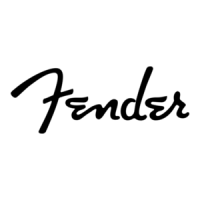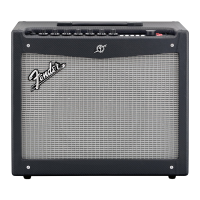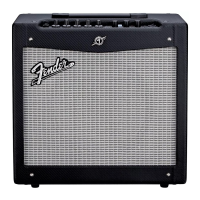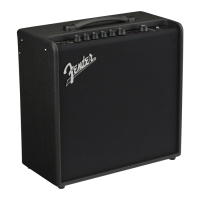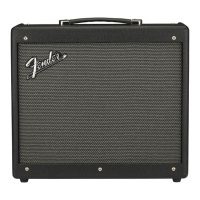
Do you have a question about the Fender Mustang GTX Series and is the answer not in the manual?
| Amplifier Type | Digital |
|---|---|
| Wattage | 100 Watts |
| Speaker | 1 x 12" Celestion |
| Connectivity | Bluetooth, USB, 1/8" aux input, headphone output |
| Footswitch | Included 7-button footswitch |
| Dimensions | 17.5" x 10.5" |
| Weight | 22 lbs (9.97 kg) |
| Number of Models | 40 |
| Presets | 200 |
| Channels | 1 |
| Effects | Dozens of effects including reverb, delay, modulation, and more |
| Amp Models | Dozens of amp models |
Detailed descriptions of all front panel controls, buttons, and the display window.
Explanation of rear panel ports including IEC power, USB, Footswitch, Line Out, and FX Send/Return.
Explanation of the three preset layers: Preset, Signal Path, and Controls.
How to view and edit amplifier models and effects within the signal path.
Accessing and adjusting amp and effect parameters in the Controls layer.
How to save edited presets using SAVE, RENAME, and SAVE AS NEW options.
Synchronizing physical knob positions with digital settings and editing them via the Controls Layer.
Steps to replace the current amp model within a preset using the Signal Path Layer.
Details and descriptions for various amplifier models available in Mustang GTX.
Details and descriptions for various speaker cabinet models available in Mustang GTX.
How to bypass, replace, and move effects within the Signal Path Layer.
Using the X FX utility button to bypass all effects simultaneously.
How to bypass specific effects within a preset using the ENCODER.
Selecting from Stomp Box, Modulation, Delay, or Reverb categories to replace an effect.
Steps to move an effect to a different position within the preset's signal path.
How to add effects using the plus-sign placeholder in the Signal Path Layer.
Modifying individual control settings for a selected effect using the Controls Layer.
Using the TAP utility button to set tempo for Delay and Modulation effects.
Modifying time parameters for delay and modulation effects via the Controls Layer.
Synchronizing effects to BPM by setting note divisions for modulation and delay effects.
Descriptions of available Stompbox effects, including their inspirations.
Descriptions of available Modulation effects and their characteristics.
Details and descriptions for various delay effects available in Mustang GTX.
Details and descriptions for various reverb effects available in Mustang GTX.
Details and descriptions for Dynamics+EQ effects.
Details and descriptions for Filters+Pitch effects.
Introduction to the MENU utility button and its available functions.
Step-by-step guide to creating, adding presets, and managing Setlists.
How to quickly save a favorite preset to the 'FAVORITES' Setlist.
Using a shortcut to quickly access the Setlist view from the control panel.
Steps to enable WiFi, select a network, and connect to it.
Manually adding a hidden network by entering its credentials.
Steps to enable Bluetooth and pair external devices for audio streaming.
Controlling Bluetooth volume via the amp's MASTER VOLUME or menu options.
How to access the built-in chromatic tuner via the TAP button or MENU.
Interpreting the note display, pitch bars, and green indicator for tuning.
Using the auxiliary input for external devices and the headphone output.
Connecting via USB for computer audio recording and driver setup.
Connecting to external gear and using the effects loop for processing.
Information on GTX-7, MGT-4 footswitches, and EXP-1 Expression Pedal compatibility.
Overview of the GTX-7 footswitch buttons, LEDs, and display window.
Navigating and selecting presets using the GTX-7 in Presets Mode.
Controlling effects on/off and assigning categories using the GTX-7 in Effects Mode.
Assigning effect categories (Stompbox, Modulation, etc.) to footswitch buttons.
How to record, overdub, and play back loops using the footswitch.
Activating and using the chromatic tuner via the GTX-7 footswitch.
Switching between Volume and Expression modes and initial setup.
Configuring the EXP-1 to control amp or effect parameters within specific presets.
Assigning specific parameters and adjusting settings in Controls Layer and Volume mode.
Setting the EXP-1 mode source to 'Preset' or 'Pedal' for global control.
Setting the global volume range for the EXP-1 pedal.
Selecting from nine EQ profiles to adjust overall amp response to environments.
Adjusting gain for USB and line out connections.
Moving, clearing, or restoring presets in the amplifier's list.
Restoring only the factory presets and amplifier settings.
Restoring all factory presets and amplifier settings to their original state.
Displaying the amp model and current firmware version.
Connecting to Fender Tone app to access, download, and share cloud presets.
Steps to back up presets and setlists to the cloud using the Fender Tone app.
Restoring previously backed-up presets and setlists from the cloud.
Removing backup files from the cloud via the Fender Tone app.
Steps to update the amplifier's firmware via WiFi connection.
Initiating Restore All, WiFi Update/Restore, Force Update, and Recovery modes.
Overview of app features for preset management, editing, and community access.
Power, impedance, speaker, dimensions, and part numbers for the GTX50 model.
Power, impedance, speaker, dimensions, and part numbers for the GTX100 model.

